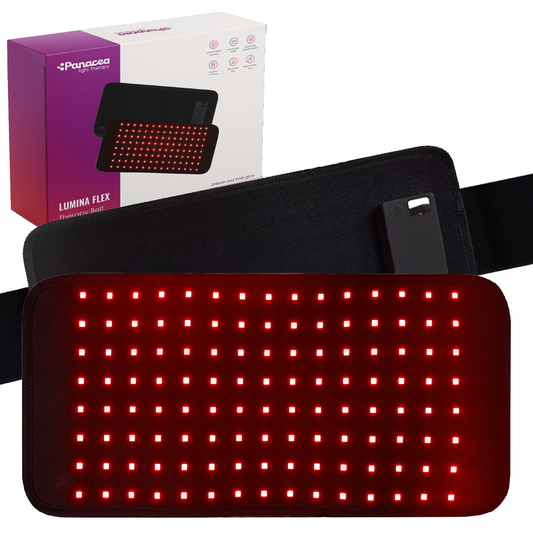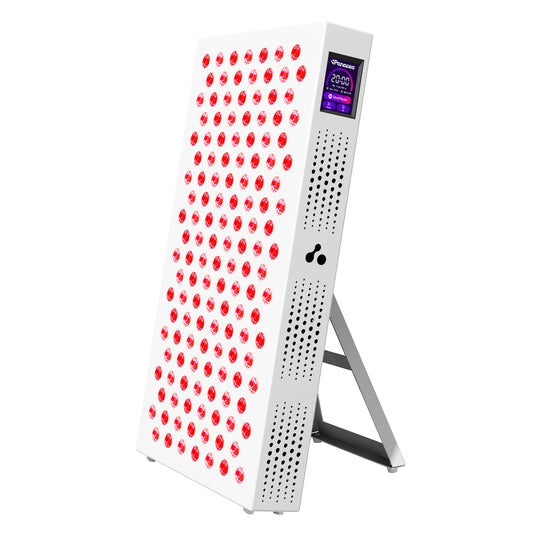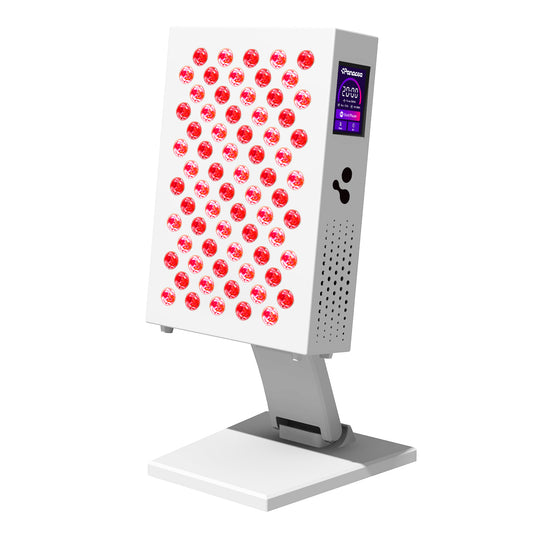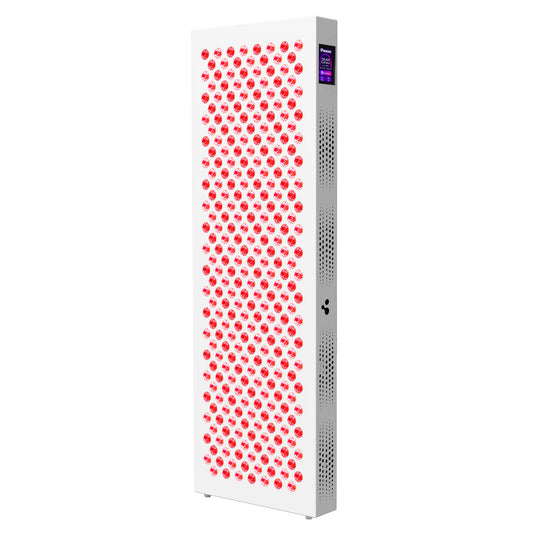
What is Red Light Therapy and Why is it Healthy?
Introduction to Red Light Therapy
Red light therapy, also known as photobiomodulation, is an innovative and increasingly popular treatment method that uses specific wavelengths of red and near-infrared light. This therapy uses concentrated light to provide a variety of health benefits without the use of harmful UV rays, chemicals, or heat. The technique helps improve blood circulation, promotes skin repair, reduces oxidative stress, and increases energy production in cells.
Why Light Is So Important
Light plays an essential role in our daily lives. Sunlight provides us with warmth and vitamin D, and helps us maintain the rhythm of day and night. In addition to the visible light spectrum, which is measured in nanometers (nm), light also contains therapeutic wavelengths. Red light is between 620 and 700 nm, while near-infrared light is between 700 and 1000 nm. These specific wavelengths are not visible and also have proven health benefits.
How Does Red Light Therapy Work?
Red light therapy uses light waves that penetrate deep into the skin and improve cell function. Near infrared light can penetrate very deep into tissues, up to 5-8 cm. Thousands of scientific studies have shown that these wavelengths are a powerful source of energy that helps the body function better, both in terms of appearance, performance and general well-being. It is therefore not surprising that red light therapy is popular with dermatologists, beauticians and professional athletes.
Benefits of Red Light Therapy
Red light therapy offers a wide range of benefits, including:
- Anti-aging : It promotes youthful and radiant skin by stimulating the production of collagen and elastin.
- Improved performance : It increases physical and mental capacity by stimulating energy production in the cells.
- Weight Management : It supports weight loss by improving metabolism.
- Anti-inflammatory : It reduces inflammation responsible for chronic conditions such as arthritis and diabetes.
- Skin Improvement : It effectively treats scars, acne, stretch marks, eczema and accelerates wound healing.
Our Red Light Therapy products can be found in our shop .
Natural Sources of Red Light
Red light and near-infrared light are naturally present in sunlight, especially during sunrise and sunset. These wavelengths help our bodies to feel more energetic and cheerful. Unfortunately, during the short and dark winter months, we don’t get enough of this beneficial light, especially if we spend a lot of time indoors.
What Should You Pay Attention to with Red Light Therapy?
Not all light sources are suitable for therapeutic use. Infrared lamps in saunas mainly generate heat without the right healing wavelengths. In addition, some commercial devices are not powerful enough, despite offering the right wavelengths. Blue light from electronic devices can be harmful if used excessively and UVB radiation from the sun can accelerate skin aging.
Panacea Light Therapy: Innovation in Light Technology
Our Panacea Light Therapy devices, especially the ATP Pro models, are equipped with advanced LED technology that emits light in the most effective wavelengths: 630 nm, 660 nm, 810 nm, 830 nm and 850 nm. These devices are designed to penetrate deep into the skin and offer a wide range of health benefits, from skin improvement to muscle recovery. They have a strong therapeutic effect, such as improving energy production in the mitochondria and stimulating cell repair.
The Mechanisms of Red Light Therapy
Red light therapy works by activating the mitochondria, the powerhouses of our cells. By absorbing light in the wavelengths of 630 nm to 850 nm, the mitochondria increase their production of ATP (adenosine triphosphate), which is essential for cell energy and function. This increases the overall health of cells and tissues, and supports repair processes throughout the body.
Broad Impact of Red Light Therapy
Red light therapy has a systemic effect that extends beyond the treated area. Studies have shown that red light treatment can accelerate wound healing even in untreated areas of the body, indicating overall improved cellular function and healing.
Importance of Light Intensity
For effective treatment, the light intensity is crucial, expressed in milliwatts per square centimeter (mw/cm²). This is measured at a distance of 15 cm from the light source. As you move further away from the source, the intensity decreases. It is essential to know how a device has been tested and certified to guarantee the therapeutic value. The ATP Pro series has a h high light intensity of 217mw/cm2 at a distance of 7.5cm.
Panacea Light Therapy Standards
Our ATP Pro models are designed to deliver the optimal therapeutic light intensity in the most effective wavelengths. These devices use five different wavelengths and near infrared light to provide a wide range of health benefits. Each new production is tested in independent laboratories to ensure you receive the highest quality and effectiveness. From a distance of 15 cm, our system quickly provides the optimal therapeutic dose of "healing light".
At Panacea Light Therapy, we believe in the power of red light therapy and want to make this science simple and accessible to everyone. Whether you are a newcomer or an experienced practitioner, our team is here to help you with all your questions and guide you to better health with our advanced technology.
The science
There are many scientific studies that show the benefits and effects of red light therapy. Below is a selection of some of the most significant studies:
Hamblin, M. R. (2018). Mechanisms and applications of the anti-inflammatory effects of photobiomodulation. AIMS Biophysics, 5(4), 324-343.
This review discusses the anti-inflammatory effects of red light therapy and the mechanisms underlying these effects. The study shows that red light exposure can help reduce inflammation by inhibiting pro-inflammatory cytokines and stimulating the production of anti-inflammatory cytokines.
de Sousa, RA, et al. (2018). Effects of photobiomodulation therapy, pharmacological therapy, and physical exercise as single and/or combined treatment on the inflammatory response induced by experimental osteoarthritis. Lasers in Medical Science, 33(7), 1419-1429.
This study investigated the effect of red light therapy on inflammation in patients with osteoarthritis. The results showed that exposure to red light can help reduce inflammation and pain in patients with this condition.
Chung H, Dai T, Sharma SK, Huang YY, Carroll JD, Hamblin MR. The nuts and bolts of low-level laser (light) therapy . Ann Biomed Eng. 2012;40(2):516-533. doi:10.1007/s10439-011-0454-7
This review describes the action of red light therapy at wavelengths of 660 nm and 850 nm and suggests that these wavelengths can be used in the treatment of various conditions including wound healing, arthritis and neuropathic pain. The authors suggest that these wavelengths work by stimulating the mitochondrial activity in the cells.
Huang, YY, et al. (2011). Biphasic dose response in low level light therapy. Dose Response, 9(4), 602-618.
This study investigated the effects of different doses of red light therapy on cellular processes in the body. The results showed that red light therapy has a biphasic dose response, meaning that different doses have different effects.
Our Red Light Therapy products can be found in our shop .







